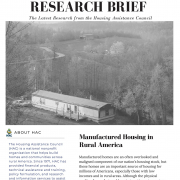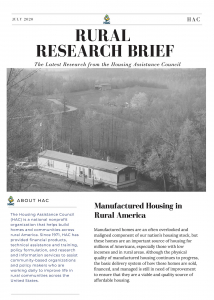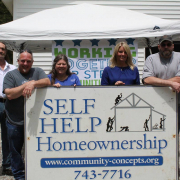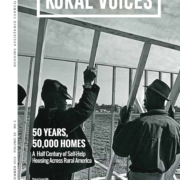A Half Century of Self-Help Housing Across Rural America
This edition of Rural Voices, “50 Years, 50,000 Homes,” celebrates the construction of the 50,000th self-help home to be built with USDA support and the achievements of the nonprofit sponsors, the USDA programs, and most importantly, the families who have become successful homeowners.
A Half Century of Self-Help Housing Across Rural America
Download a pdf version of Rural Voices
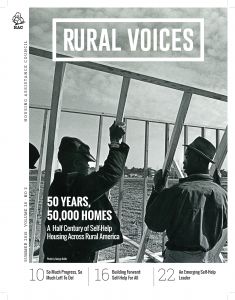
This edition of Rural Voices, “50 Years, 50,000 Homes,” celebrates the construction of the 50,000th self-help home to be built with USDA support and the achievements of the nonprofit sponsors, the USDA programs, and most importantly, the families who have become successful homeowners.
Views from Washington
Successful Federal-Local Partnerships
by U.S. Representative Harold “Hal” Rogers
Local partners help USDA housing programs make meaningful impacts to the lives of local rural residents
Neighbors Helping Neighbors Build a Better Life
by U.S. Representative Sam Farr
A program that helped create the real American Dream for over 50 years.
With Many Dedicated Partners, USDA Helps 50,000 Families Achieve the American Dream
by Secretary Tom Vilsack
USDA Secretary Tom Vilsack discusses USDA’s Self-Help Housing Program.
FEATURES
So Much Progress, So Much Left To Do!
by Peter Carey
A simple concept still holds promise in a complicated housing world
Looking Back: The Beginnings and Evolution of USDA’s Self-Help Housing Movement
by Bob Marshall
Early efforts in rural California became a Self-Help Housing model for the nation
Building Forward: Self-Help For All
by Russell Huxtable
Let’s build on fifty years of history and expand this life changing program!
Self-Help Housing Changed Our Lives
by Noelle McKay and Stefanie Kompathoum
Families share their experience with the Self-Help Housing Program
An Emerging Self-Help Leader
by Mi’shell French
Discusses personal growth and sustaining the momentum through Self-Help Housing
Self-Help Housing and “SHOP” in the Rio Grande Valley
by Nancy Hanson
HUD’s Self -Help Homeownership Opportunity Program helps make self-help building sites affordable
Technical Assistance is the Essential Ingredient to Self-Help Housing
by Suzy Huard
USDA’S Section 523 Technical Assistance Grants make Mutual Self-Help housing possible
Expanding Service in Michigan’s Upper Peninsula
by Mike Shimon
A local Habitat for Humanity provider reaches more families using the USDA Mutual Self-Help program
Neither Wind, Nor Rain…Can Stop a Determined Self-Help Provider
by Linda Smith
A local nonprofit is up to the challenge when disaster strikes twice.
Additional Content
 Celebrating 50 Years of helping families help themselves.(8.5″ X 11″ printable pdf)
Celebrating 50 Years of helping families help themselves.(8.5″ X 11″ printable pdf)
Celebrating 50 Years of helping families help themselves.(25.5″ X 11″ original document)
Rural Voices would like to hear what you have to say about one, or all, of these issues. Please feel free to comment on this story by sending a tweet to #RuralVoicesMag, discuss on the Rural Affordable Housing Group on LinkedIn, or on our Facebook page.




